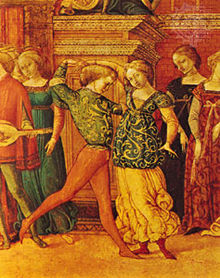 The word carol comes from the old French word carole, a circle dance accompanied by singers. Carols were very popular as dance songs during the 12 through 14th centuries. After that, their use expanded as songs sung during festivals. Because they are dance songs many Christmas carols are in 3/4 time. In the early years of caroling, it was common to have one lead singer surrounded by dancers who sang the accompaniment. Traditional attributes of a Christmas carol include celebrating Christ’s birth, alternating verses and chorus, and danceable music. Over time, people began referring to any Christmas song as a Christmas carol. Are all Christmas carols carols? I’ll let you decide.
The word carol comes from the old French word carole, a circle dance accompanied by singers. Carols were very popular as dance songs during the 12 through 14th centuries. After that, their use expanded as songs sung during festivals. Because they are dance songs many Christmas carols are in 3/4 time. In the early years of caroling, it was common to have one lead singer surrounded by dancers who sang the accompaniment. Traditional attributes of a Christmas carol include celebrating Christ’s birth, alternating verses and chorus, and danceable music. Over time, people began referring to any Christmas song as a Christmas carol. Are all Christmas carols carols? I’ll let you decide.
The History of Christmas Carols
Carols were first sung in Europe thousands of years ago, but these were not Christmas carols. They were pagan songs, sung at the Winter Solstice celebrations as people danced round stone circles. (The word carol originally meant to dance to something). The Winter Solstice is the shortest day of the year, usually taking place around the 22nd December. The word carol actually means dance or a song of praise and joy! Carols used to be written and sung during all four seasons, but only the tradition of singing them at Christmas has really survived.
Early Christians took over the pagan solstice celebrations for Christmas and gave people Christian songs to sing instead of pagan ones. In AD 129, a Roman Bishop said that a song called “Angel’s Hymn” should be sung at a Christmas service in Rome. Another famous early Christmas hymn was written in 760AD, by Comas of Jerusalem, for the Greek Orthodox Church. Soon after this many composers all over Europe started to write ‘Christmas carols.’ However, not many people liked them as they were all written and sung in Latin, a language that the normal people couldn’t understand. By the Middles Ages (the 1200s), most people had lost interest in celebrating Christmas, altogether.
This was changed by St. Francis of Assisi when, in 1223, he started his Nativity Plays in Italy. The people in the plays sang songs or ‘canticles’ that told the story during the plays. Sometimes, the choruses of these new carols were in Latin; but normally they were all in a language that the people watching the play could understand and join in! The new carols spread to France, Spain, Germany and other European countries.
The earliest carol, like this, was written in 1410. Sadly only a very small fragment of it still exists. The carol was about Mary and Jesus meeting different people in Bethlehem. Most Carols from this time and the Elizabethan period are untrue stories, very loosely based on the Christmas story, about the holy family and were seen as entertaining rather than religious songs. They were usually sung in homes rather than in churches! Traveling singers or Minstrels started singing these carols and the words were changed for the local people wherever they were traveling. One carols that changed like this is “I Saw Three Ships.”
via The History of Christmas Carols — Christmas Customs and Traditions — whychristmas?com.
